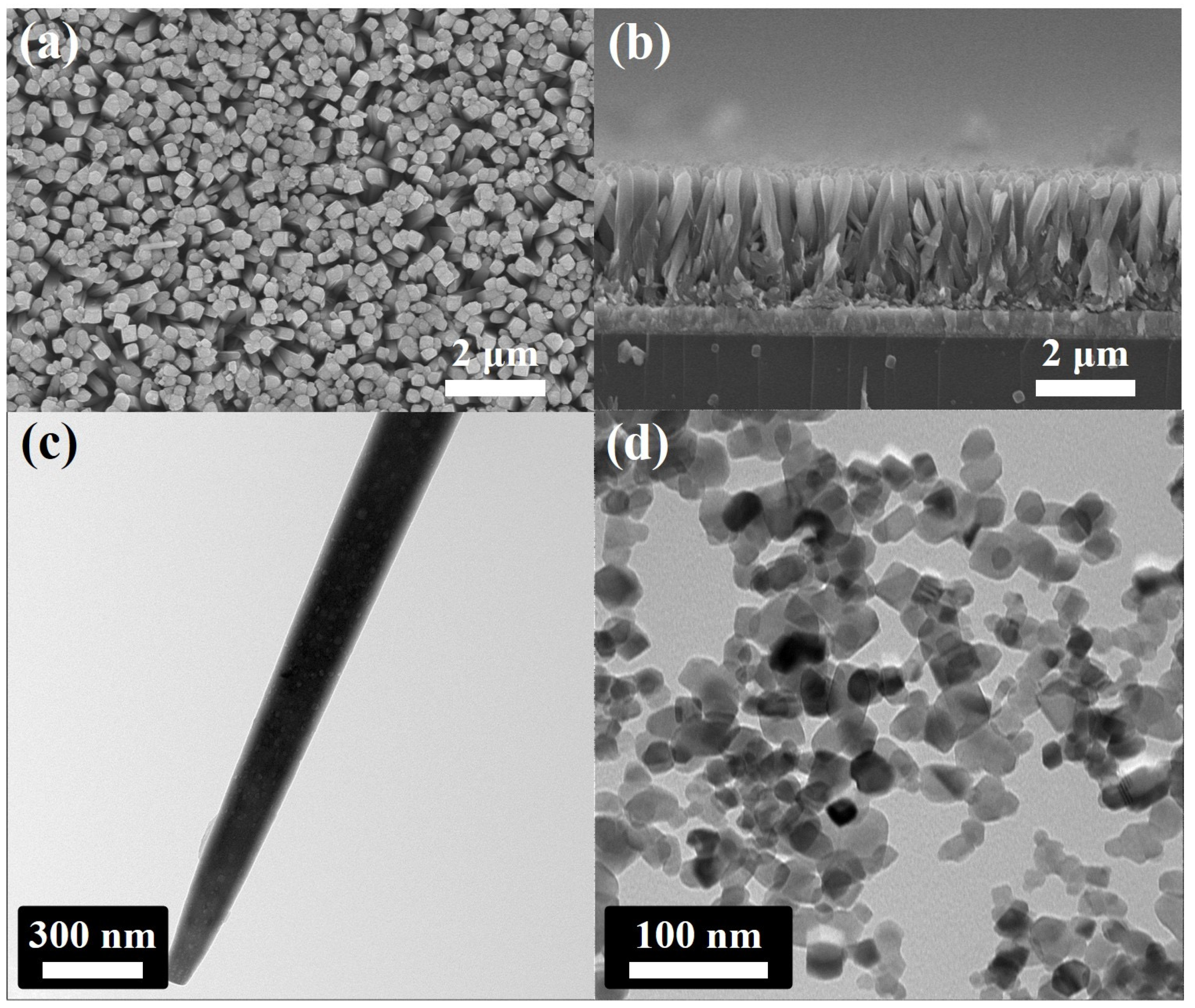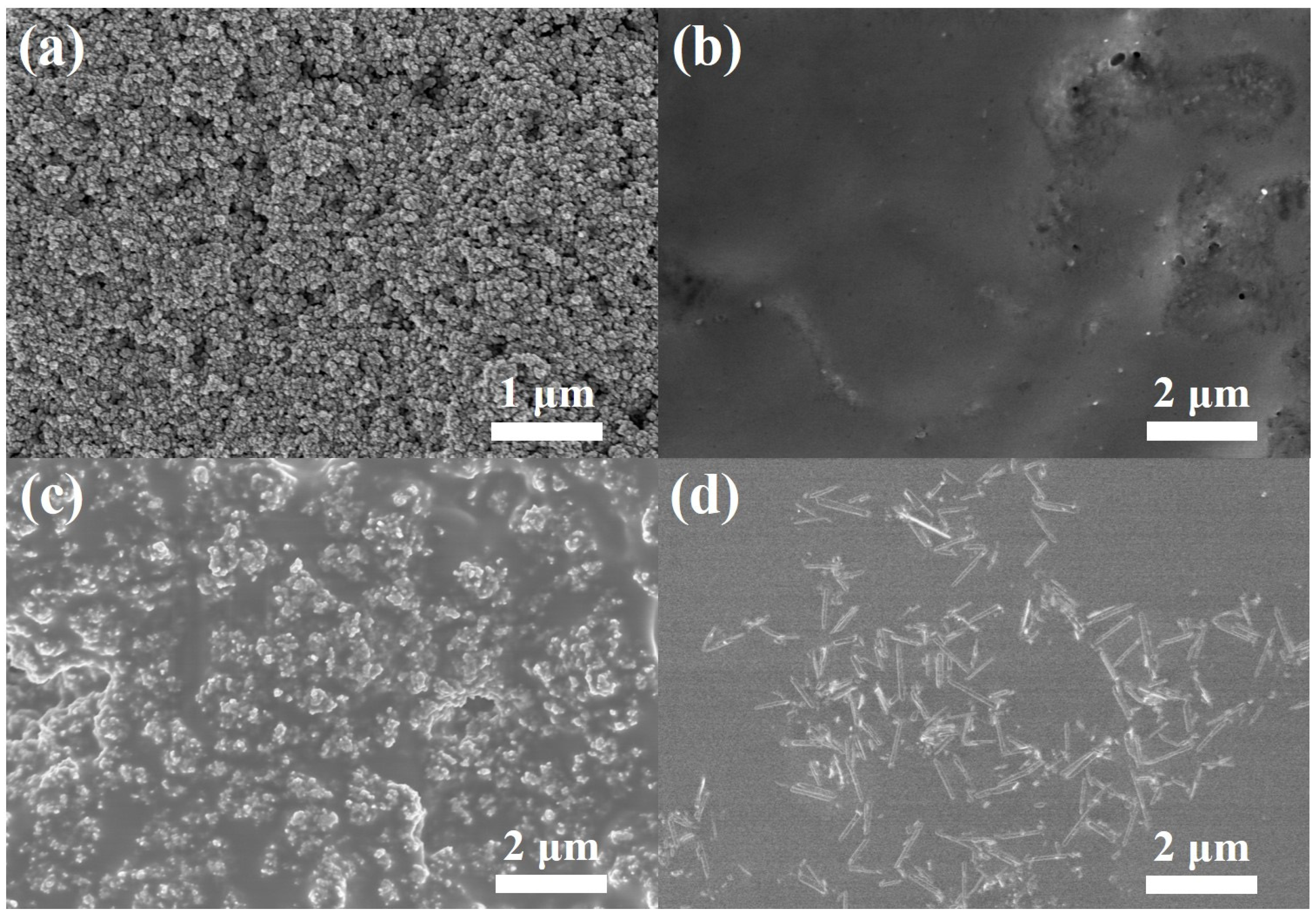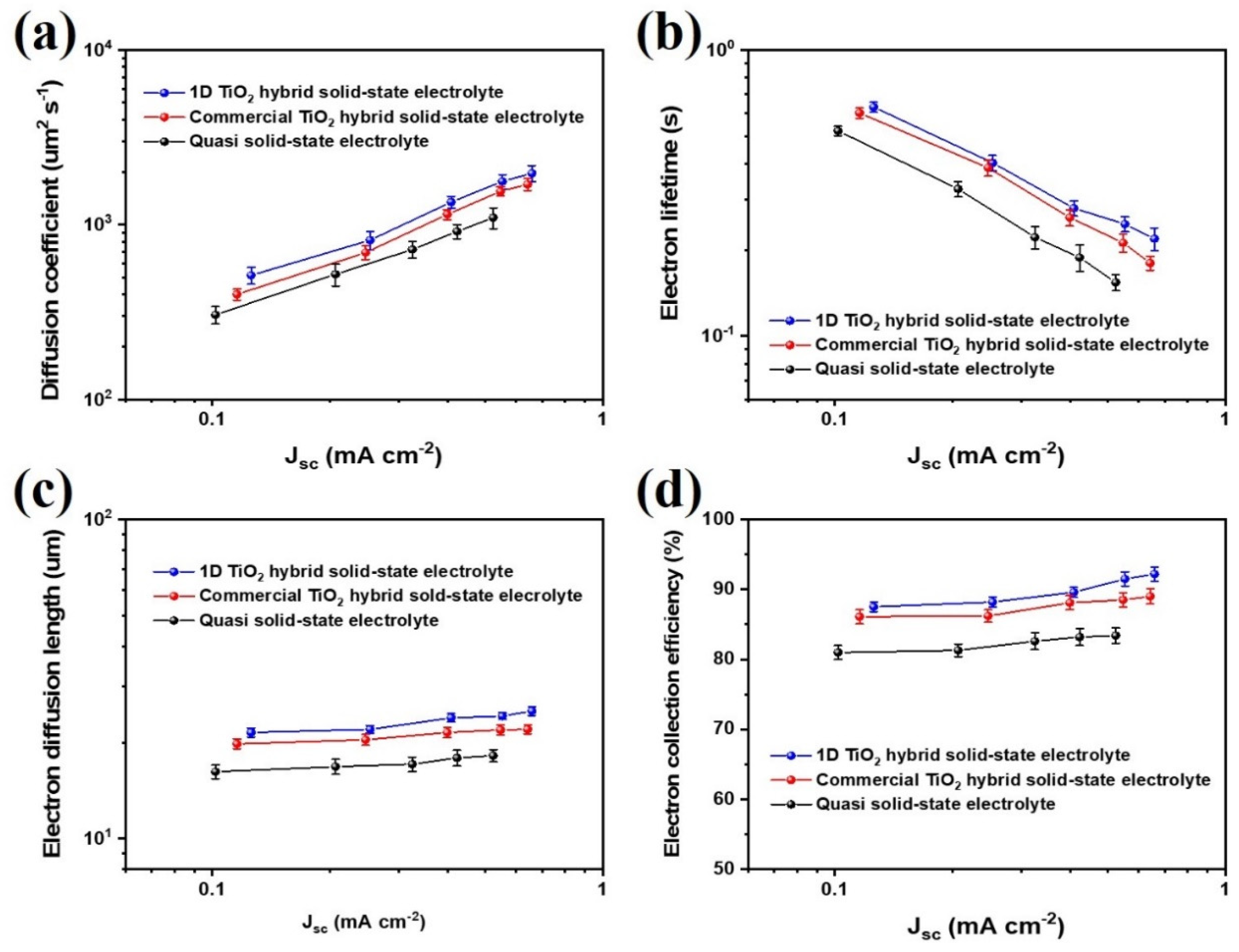Shape-Controlled TiO2 Nanomaterials-Based Hybrid Solid-State Electrolytes for Solar Energy Conversion with a Mesoporous Carbon Electrocatalyst
Abstract
:1. Introduction
2. Experimental Section
2.1. Materials
2.2. Preparation of 1D TiO2 Hybrid Solid-State Electrolyte
2.3. Preparation of Mesoporous Carbon Electrocatalyst Based Counterelectrode
2.4. Preparation of 1D TiO2 Hybrid Solid-State Electrolyte Based DSSCs
2.5. Characterization
3. Results and Discussion
4. Conclusions
Supplementary Materials
Author Contributions
Funding
Institutional Review Board Statement
Informed Consent Statement
Data Availability Statement
Conflicts of Interest
References
- Chu, S.; Majumdar, A. Opportunities and challenges for a sustainable energy future. Nature 2012, 488, 294. [Google Scholar] [CrossRef] [PubMed]
- O’Regan, B.; Grätzel, M. A low-cost, high-efficiency solar cell based on dye-sensitized colloidal TiO2 films. Nature 1991, 353, 737. [Google Scholar] [CrossRef]
- Gong, J.; Sumathy, K.; Qiao, Q.; Zhou, Z. Review on dye-sensitized solar cells (DSSCs): Advanced techniques and research trends. Renew. Sust. Energ. Rev. 2017, 68, 234. [Google Scholar] [CrossRef]
- Li, B.; Wang, L.; Kang, B.; Wang, P.; Qiu, Y. Review of recent progress in solid-state dye-sensitized solar cells. Sol. Energy Mater. Sol. Cells 2006, 90, 549. [Google Scholar] [CrossRef]
- Venkatesan, S.; Lee, Y.-L. Nanofillers in the electrolytes of dye-sensitized solar cells—A short review. Coord. Chem. Rev. 2017, 353, 58. [Google Scholar] [CrossRef]
- Kim, J.H.; Kang, M.-S.; Kim, Y.J.; Won, J.; Park, N.-G.; Kang, Y.S. Dye-sensitized nanocrystalline solar cells based on composite polymer electrolytes containing fumed silica nanoparticles. Chem. Commun. 2004, 1662. [Google Scholar] [CrossRef] [PubMed]
- Wu, J.H.; Hao, S.C.; Lan, Z.; Lin, J.M.; Huang, M.L.; Huang, Y.F.; Fang, L.Q.; Yin, S.; Sato, T. A Thermoplastic gel electrolyte for stable quasi-solid-state dye-sensitized solar cells. Adv. Funct. Mater. 2007, 17, 2645. [Google Scholar] [CrossRef]
- Wang, P.; Zakeeruddin, S.M.; Moser, J.E.; Nazeeruddin, M.K.; Sekiguchi, T.; Grätzel, M. A stable quasi-solid-state dye-sensitized solar cell with an amphiphilic ruthenium sensitizer and polymer gel electrolyte. Nat. Mat. 2003, 2, 402. [Google Scholar] [CrossRef]
- Hayamizu, K.; Aihara, Y.; Arai, S.; Price, W.S. Diffusion, conductivity and DSC studies of a polymer gel electrolyte composed of cross-linked PEO, g-butyrolactone and LiBF4. Solid State Ion. 1998, 107, 1–12. [Google Scholar] [CrossRef]
- Kuila, T.; Acharya, H.; Srivastava, S.K.; Samantaray, B.K.; Kureti, S. Enhancing the ionic conductivity of PEO based plasticized composite polymer electrolyte by LaMnO3 nanofiller. Mater. Sci. Eng. B Solid State Mater. Adv. Technol. 2007, 137, 217. [Google Scholar] [CrossRef]
- Park, J.T.; Ahn, S.H.; Roh, D.K.; Lee, C.S.; Kim, J.H. Multifunctional organized mesoporous tin oxide films templated by graft copolymers for dye-sensitized solar cells. ChemSusChem 2014, 7, 2037. [Google Scholar] [CrossRef]
- Yang, H.; Huang, M.; Wu, J.; Lan, Z.; Hao, S.; Lin, J. The polymer gel electrolyte based on poly(methyl methacrylate) and its application in quasi-solid-state dye-sensitized solar cells. Mater. Chem. Phys. 2008, 110, 38. [Google Scholar] [CrossRef]
- Lim, S.M.; Moon, J.; Choi, G.H.; Baek, U.C.; Lim, J.M.; Park, J.T.; Kim, J.H. Surface carbon shell-functionalized ZrO2 as nanofiller in polymer gel electrolyte-based dye-sensitized solar cells. Nanomaterials 2019, 9, 1418. [Google Scholar] [CrossRef] [Green Version]
- Yoon, I.-N.; Song, H.; Won, J.; Kang, Y.S. Shape dependence of SiO2 nanomaterials in a quasi-solid electrolyte for application in dye-sensitized solar cells. J. Phys. Chem. C 2014, 118, 3918. [Google Scholar] [CrossRef]
- Zebardastan, N.; Khanmirzaei, M.H.; Ramesh, S.; Ramesh, K. Novel poly(vinylidene fluoride-co-hexafluoro propylene)/polyethylene oxide based gel polymer electrolyte containing fumed silica (SiO2) nanofiller for high performance dye-sensitized solar cell. Electrochim. Acta 2016, 220, 573. [Google Scholar] [CrossRef]
- Chae, H.; Song, D.; Lee, Y.-G.; Son, T.; Cho, W.; Pyun, Y.B.; Kim, T.-Y.; Lee, J.H.; Fabregat-Santiago, F.; Bisquert, J.; et al. Chemical effects of tin oxide nanoparticles in polymer electrolytes-based dye-sensitized solar cells. J. Phys. Chem. C 2014, 118, 16510. [Google Scholar] [CrossRef]
- Sivakumar, R.; Akila, K.; Anandan, S. New type of inorganic-organic hybrid (heteropolytungsticacid–polyepichlorohydrin) polymer electrolyte with TiO2 nanofiller for solid state dye sensitized solar cells. Curr. Appl. Phys. 2010, 10, 1255. [Google Scholar] [CrossRef]
- Wieczorek, W. Composite polyether based solid electrolytes. The Lewis acid-base approach. Solid State Ion. 1996, 85, 67. [Google Scholar] [CrossRef]
- Moon, J.; Shin, W.; Park, J.T.; Jang, H. Solid-state solar energy conversion from WO3 nano and microstructures with charge transportation and light-scattering characteristics. Nanomaterials 2019, 9, 1797. [Google Scholar] [CrossRef] [Green Version]
- Wagemaker, M.; Kearley, G.J.; van Well, A.A.; Mutka, H.; Mulder, F.M. Multiple Li positions inside oxygen octahedra in lithiated TiO2 anatase. J. Am. Chem. Soc. 2003, 125, 840. [Google Scholar] [CrossRef] [PubMed]
- Zhai, T.; Fang, X.; Liao, M.; Xu, X.; Zeng, H.; Yoshio, B.; Golberg, D. A comprehensive review of one-dimensional metal-oxide nanostructure photodetectors. Sensors 2009, 9, 6504. [Google Scholar] [CrossRef] [PubMed]
- Devan, R.S.; Patil, R.A.; Lin, J.-H.; Ma, Y.-R. One-dimensional metal-oxide nanostructures: Recent developments in synthesis, characterization, and applications. Adv. Funct. Mater. 2014, 22, 3326. [Google Scholar] [CrossRef]
- Ibrahim, I.; Lim, H.N.; Wan, N.W.K.; Huang, N.M.; Lim, S.P.; Busayaporn, W.; Nakajima, H. Plasmonic silver sandwich structured photoanode and reflective counter electrode enhancing power conversion efficiency of dye-sensitized solar cell. Sol. Energy 2021, 215, 403. [Google Scholar] [CrossRef]
- He, Y.; Wang, W. ZIF-8 and three-dimensional graphene network assisted DSSCs with high performances. J. Solid State Chem. 2021, 296, 121992. [Google Scholar] [CrossRef]
- He, G.; Wang, P.; Feng, K.; Dong, H.; Zhao, H.; Sun, F.; Yin, H.; Li, W.; Li, G. Efficient fabrication of diverse mesostructured materials from the self-assembly of pyrrole-containing block copolymers and their confined chemical transformation. Macromolecules 2021, 54, 906. [Google Scholar] [CrossRef]
- Park, J.T.; Patel, R.; Jeon, H.; Kim, D.J.; Shin, J.-S.; Kim, J.H. Facile fabrication of vertically aligned TiO2 nanorods with high density and rutile/anatase phases on transparent conducting glasses: High efficiency dye-sensitized solar cells. J. Mat. Chem. 2012, 22, 6131. [Google Scholar] [CrossRef]
- Choi, G.H.; Kim, D.J.; Moon, J.; Kim, J.H.; Park, J.T. High-order diffraction grating as light harvesters for solar energy conversion. J. Electroanal. Chem. 2020, 873, 114490. [Google Scholar] [CrossRef]
- Lee, J.Y.; Choi, G.H.; Moon, J.; Chi, W.S.; Park, J.T. 1D Co4S3 nanoneedle array with mesoporous carbon derived from double comb copolymer as an efficient solar conversion catalyst. Appl. Surf. Sci. 2021, 535, 147637. [Google Scholar] [CrossRef]
- Kim, Y.E.; Baek, U.C.; Kim, J.H.; Chi, W.S.; Park, J.T. Harnessing SnO2 nanotube light scattering cluster to improve energy conversion efficiency assisted by high reflectance. Mater. Chem. Phys. 2020, 254, 123538. [Google Scholar] [CrossRef]
- Svanberg, C.; Adebahr, J.; Ericson, H. Diffusive and segmental dynamics in polymer gel electrolytes. J. Chem. Phys. 1999, 111, 11216. [Google Scholar] [CrossRef]
- Aziz, S.B.; Woo, T.J.; Kadir, M.F.Z.; Ahmed, H.M. A conceptual review on polymer electrolytes and ion transport models. J. Sci. 2018, 3, 1. [Google Scholar] [CrossRef]
- Kim, H.; Yang, B.L. Effect of seed layers on TiO2 nanorod growth on FTO for solar hydrogen generation. Int. J. Hydrog. Energy 2015, 40, 5807. [Google Scholar] [CrossRef]
- Zhao, Y.; Zhai, J.; Wei, T.X.; Jiang, L.; Zhu, D.B. Enhanced photoelectrical performance of TiO2 electrodes integrated with microtube-network structures. J. Mater. Chem. 2007, 17, 5084. [Google Scholar] [CrossRef]
- Tiwana, P.; Docampo, P.; Johnston, M.B.; Snaith, H.J.; Herz, L.M. Electron mobility and injection dynamics in mesoporous ZnO, SnO2, and TiO2 films used in dye-sensitized solar cells. ACS Nano 2011, 5, 5158. [Google Scholar] [CrossRef] [PubMed]
- Park, J.T.; Chi, W.S.; Jeon, H.; Kim, J.H. Improved electron transfer and plasmonic effect in dye-sensitized solar cells with bi-functional Nb-doped TiO2/Ag ternary nanostructures. Nanoscale 2014, 6, 2718. [Google Scholar] [CrossRef]
- Karakuş, M.Ö.; Yakışıklıer, M.E.; Delibaş, A.; Ayyıldız, E.; Çetin, H. Anionic and cationic polymer-based quasi-solid-state dye-sensitized solarcell with poly(aniline) counter electrode. Sol. Energy 2020, 195, 565. [Google Scholar] [CrossRef]
- Kumar, S.; Manikandan, V.S.; Panda, S.K.; Senanayak, S.P.; Palai, A.K. Probing synergistic outcome of graphene derivatives in solid-state polymer electrolyte and Pt-free counter electrode on photovoltaic performances. Sol. Energy 2020, 208, 949. [Google Scholar] [CrossRef]
- Mohan, K.; Bora, A.; Roy, R.S.; Nath, B.C.; Dolui, S.K. Polyaniline nanotube/reduced graphene oxide aerogel as efficient counterelectrode for quasi solid state dye sensitized solar cell. Sol. Energy 2019, 186, 360. [Google Scholar] [CrossRef]
- Utomo, D.S.; Kim, J.H.; Lee, D.; Park, J.; Kang, Y.-C.; Kim, Y.H.; Choi, J.W.; Song, M. Fractional structured molybdenum oxide catalyst as counter electrodes of all-solid-state fiber dye-sensitized solar cells. J. Colloid Interface Sci. 2021, 584, 520. [Google Scholar] [CrossRef]
- Xia, J.; Wang, Q.; Chen, M.; Li, W.; Liu, J.; Chen, J.; Wu, H.; Fan, S. Bifacial quasi-solid-state dye-sensitized solar cell with metal selenide M0.85Se (M = Co, Ni) as counter electrode. Electrochim. Acta 2019, 307, 422. [Google Scholar] [CrossRef]
- Yoo, B.; Kim, K.; Lee, D.-K.; Ko, M.J.; Lee, H.; Kim, Y.H.; Kim, W.M.; Park, N.-G. Enhanced charge collection efficiency by thin-TiO2-film deposition on FTO-coated ITO conductive oxide in dye-sensitized solar cells. J. Mater. Chem. 2010, 20, 4392. [Google Scholar] [CrossRef]







| Electrolyte | Voc (V) | Jsc g (mA/cm2) | Jsc h (mA/cm2) | FF | η (%) |
|---|---|---|---|---|---|
| Quasi solid-state electrolyte | 0.60 ± 0.04 | 10.7 ± 0.7 | 10.3 | 0.59 ± 0.02 | 3.9 ± 0.20 |
| Commercial TiO2 hybrid solid-state electrolyte | 0.63 ± 0.04 | 12.7 ± 0.4 | 12.0 | 0.60 ± 0.01 | 4.8 ± 0.15 |
| 1D TiO2 hybrid solid-state electrolyte | 0.65 ± 0.03 | 14.6 ± 0.6 | 13.8 | 0.64 ± 0.03 | 6.1 ± 0.20 |
| Electrolyte | Rs (Ω) | R1 (Ω) | R2 (Ω) | Ws (Ω) |
|---|---|---|---|---|
| Quasi solid-state electrolyte | 21.6 ± 3.5 | 9.8 ± 1.5 | 34.4 ± 5.0 | 2.4 ± 0.3 |
| Commercial TiO2 Hybrid solid-state electrolyte | 22.3 ± 3.0 | 8.7 ± 1.2 | 25.5 ± 4.5 | 2.0 ± 0.3 |
| 1D TiO2 Hybrid solid-state electrolyte | 21.1 ± 3.5 | 9.6 ± 1.5 | 20.1 ± 4.0 | 1.8 ± 0.2 |
Publisher’s Note: MDPI stays neutral with regard to jurisdictional claims in published maps and institutional affiliations. |
© 2021 by the authors. Licensee MDPI, Basel, Switzerland. This article is an open access article distributed under the terms and conditions of the Creative Commons Attribution (CC BY) license (https://creativecommons.org/licenses/by/4.0/).
Share and Cite
Lim, S.M.; Moon, J.; Baek, U.C.; Lee, J.Y.; Chae, Y.; Park, J.T. Shape-Controlled TiO2 Nanomaterials-Based Hybrid Solid-State Electrolytes for Solar Energy Conversion with a Mesoporous Carbon Electrocatalyst. Nanomaterials 2021, 11, 913. https://doi.org/10.3390/nano11040913
Lim SM, Moon J, Baek UC, Lee JY, Chae Y, Park JT. Shape-Controlled TiO2 Nanomaterials-Based Hybrid Solid-State Electrolytes for Solar Energy Conversion with a Mesoporous Carbon Electrocatalyst. Nanomaterials. 2021; 11(4):913. https://doi.org/10.3390/nano11040913
Chicago/Turabian StyleLim, Seung Man, Juyoung Moon, Uoon Chul Baek, Jae Yeon Lee, Youngjin Chae, and Jung Tae Park. 2021. "Shape-Controlled TiO2 Nanomaterials-Based Hybrid Solid-State Electrolytes for Solar Energy Conversion with a Mesoporous Carbon Electrocatalyst" Nanomaterials 11, no. 4: 913. https://doi.org/10.3390/nano11040913






